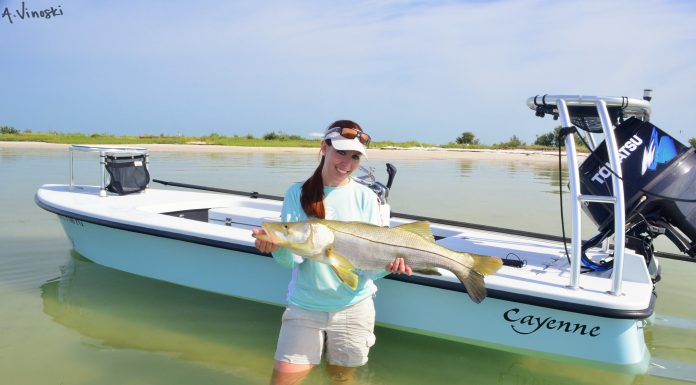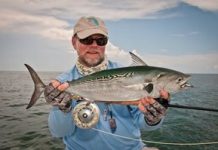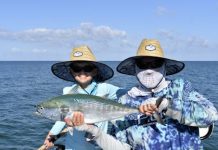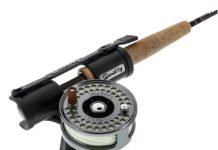
Capt. Pat Damico, Fly Fishing Editor
How can you not love an early morning stroll on the beach this time of year? Put a fly rod in your hand and some aggressive linesiders a few feet from the wash and this is close to fly rod heaven. Every year I anticipate the spawning ritual that will bring large female Snook along with their smaller male suitors within easy casting distance of our beautiful beaches. Many fly rodders have never caught a Snook. There is never a better opportunity than right now, and it’s simple.
Most beaches are a short distance from where we live. Do they all hold Snook? It’s best to concentrate on stretches of beach close to the Passes that allow Gulf access. Tidal flow will always be stronger there and all Snook feed best when there is a good moving tide. Early morning is my favorite because the fish are not disturbed by the usual activities that attract droves of people later in the day. It is cool and comfortable even thought the slight easterly wind, that is usually present, will make for relatively calm water conditions. This is essential because we are interested in sight fishing opportunities rather than blind casting where we think fish will be cruising.
Stay out of the water. Walk parallel to the trough that forms by the wash next to the sand. Most fish will be within a couple feet of the water’s edge. Baitfish will be found running parallel in this trough and Snook will be close behind. Some beaches have an elevated area close to this edge and seeing fish is easier. Irregularities in the beach where the sand meets the water will show sand bars and structure that will provide ambush points for hungry predators. Rock formations and small jetties, or some piled up driftwood will really concentrate bait and hungry Snook. Occasionally a swirl will be detected revealing a large Snook. You will find most fish facing into the tide; casting so the fly will charge them will result it failure. A baitfish will not charge a large predator and they know it. Placement of a small baitfish pattern in front of the Snook that will flee from them is the way your offering should be presented. Some of my most productive beaches are where I must use a kayak or boat to first get me there. Try to pick quiet stretches of water.
What are our equipment requirements? Eight weight, fast action rods are preferred. I shun floating lines because even slight wave action will impair their use. The newer clear sinking tip weight forward saltwater tapers will work beautifully. Because the first ten feet or so that connects to your leader is clear, a short four or five foot length of thirty pound test fluorocarbon is all that is needed. This makes leader turn over even with heavy flies a pleasure. Stripping baskets, popular in the northeast, are rarely seen here. If you will practice with one, their use in beach situations will make long casts easier to perform. A shallow waste paper basket or perforated plastic container large enough to hold line can be carried below waist level with a bungee cord around your waist. A basket will keep sand that will coat your fly line when it contacts the beach from getting into your reel. A smooth drag reel that will hold a minimum of one hundred
yards of thirty pound braided backing will complete your outfit. Large shirt pockets will carry flies, extra leader material, and a combination scissors hemostat. Fanny packs are a nice extra. Water and a camera along with a few other accessories can be easily transported especially if out for awhile.
 Fly selection will be simple. Baitfish patterns like Clouser minnows, Lefty’s Deceivers, and my Bead Butt Baitfish in predominately white colors will all work. Even though most visible baitfish will be small, larger flies seem to be preferred. After each catch, check your leader and don’t hesitate to retie when questionable.
Fly selection will be simple. Baitfish patterns like Clouser minnows, Lefty’s Deceivers, and my Bead Butt Baitfish in predominately white colors will all work. Even though most visible baitfish will be small, larger flies seem to be preferred. After each catch, check your leader and don’t hesitate to retie when questionable.
Some of the largest Snook of the year are now available. Remember this is strictly a catch and release proposition so minimum handling and stress to the fish is warranted. If you’re really adventurous, try doing this at night. This can really be a thrill!
Capt. Pat Damico, a FFF Certified Fly Casting Instructor, can be reached via his website www.captpat.com, or by calling 727-504-8649.
- Captain’s Corner:Pat Damico - June 25, 2019
- Flat water makes seeing tarpon easier - May 17, 2017
- Warm rivers holding plenty of targets for fly fishermen - February 16, 2017











